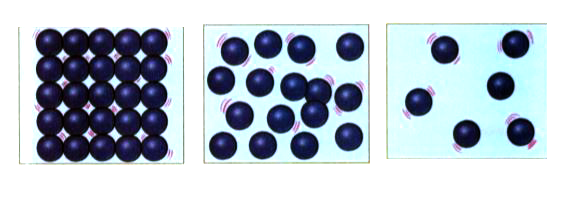(b) Why do solids, liquids and gases differ in their physical state ?
Step-by-Step Solution:
1. Understanding Intermolecular Forces:
- Solids, liquids, and gases differ primarily due to the strength of intermolecular forces of attraction between their particles.
2. Characteristics of Solids:
- In solids, particles are held together by strong intermolecular forces.
- This strong attraction keeps the particles close together with negligible intermolecular space.
- As a result, solids have a fixed shape and cannot flow.
3. Characteristics of Liquids:
- In liquids, the intermolecular forces of attraction are weaker compared to solids.
- This allows the particles to move from their initial positions, giving liquids the ability to flow.
- Liquids have moderate intermolecular spaces, which means they can take the shape of the container they are in.
4. Characteristics of Gases:
- In gases, the intermolecular forces are very weak.
- This results in large intermolecular spaces between particles.
- The particles in gases can move far apart from each other and can diffuse easily into their surroundings.
5. Conclusion:
- The differences in the physical states of solids, liquids, and gases are due to the varying strengths of intermolecular forces and the spaces between the particles.
- Strong forces and close particles in solids lead to a fixed shape, while weaker forces and more space in liquids and gases allow for flow and diffusion.
- Solids, liquids, and gases differ primarily due to the strength of intermolecular forces of attraction between their particles.
- In solids, particles are held together by strong intermolecular forces.
- This strong attraction keeps the particles close together with negligible intermolecular space.
- As a result, solids have a fixed shape and cannot flow.
- In liquids, the intermolecular forces of attraction are weaker compared to solids.
- This allows the particles to move from their initial positions, giving liquids the ability to flow.
- Liquids have moderate intermolecular spaces, which means they can take the shape of the container they are in.
- In gases, the intermolecular forces are very weak.
- This results in large intermolecular spaces between particles.
- The particles in gases can move far apart from each other and can diffuse easily into their surroundings.
- The differences in the physical states of solids, liquids, and gases are due to the varying strengths of intermolecular forces and the spaces between the particles.
- Strong forces and close particles in solids lead to a fixed shape, while weaker forces and more space in liquids and gases allow for flow and diffusion.
Topper's Solved these Questions
Similar Questions
Knowledge Check
- Question 1 - Select One
Out of solids , liquids and gases, which one has all the three types of modulus ofelasticity and why gases have only bulk modulus of elasticity.
ASolidsBLiquidsCGasesDBoth solids and liquids

a.Identify which of the above pictures shows particle arrangement in solids, liquids and gases. Write in the space below each picture.
b. Which state of matter would you expect to show a fixed volume?
c. Why do you think gases can flow whereas solids cannot?View SolutionOut of solids, liquids, and gases, which can be compressed the most?
View SolutionWhy are liquids and gases called fluids?
View SolutionCompare densities of solids, liquids, and gases.
View SolutionWhy do the liquids and gases have no linear or superficial expansion?
View SolutionWhy are liquids and gases categorised as fluids ?
View SolutionList the characteristics of solids, liquids and gases
View Solution

